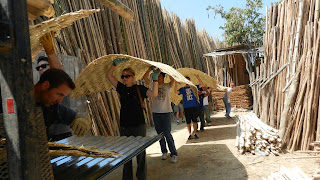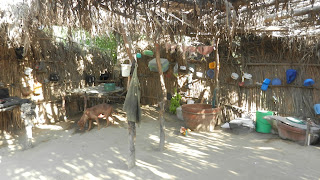Before I left, I had a lot more experiences in the market, the beach, and the final dinner.
At the market at Catacaos, a town about 1 km south of Piura, there was a fairly large market that sold many souvenirs, snacks, and paintings. This was an open market that spanned one street, and everyone found a gift suitable for their relatives and friends back home! The market was extremely cheap and I even learned how to bargain down there, as I managed to bargain a wooden puzzle from 5 sols down to 3 sols using my limited Spanish. There were especially tons of pottery and statues at the market, including many nativity scenes, reflecting on the extremely devout and admirable nature of the residents.
 |
| Missionaries from St. Anne buying pottery from the market |
 |
| Necklaces and other bracelets in the market |
I went to the beach a second time, this time with the nurses from Marquette and Shannon from Montana. This time, I dressed more appropriately and wore a t-shirt and shorts so that I could play soccer on the beach and have more fun than I did last time, when I wore jeans and could only get ankle deep into the water!
 |
| Playing soccer at the beach |
I also got to experiment more with the lunches, since we decided to order several different plates of food this time and share among ourselves. Even though the fish and chips, chicken kebabs, and different varieties of grilled foods looked extremely appetizing, I found myself drawn back to the amazing ceviche that the restaurant at the beach made! I'm pretty sure that it was better the second time because I had worked up an appetite!
|
|
| Eating lunch at the beach |
After I came back from the beach, I spent the evening before mass hanging out with the Chira family, Yolanda, Alehendro, and Jesus to talk about their living conditions and what I could do to help them when I came back to the United States. We had an amazing conversation with Shannon as our translator, and their words confirmed what I had already learnt: being adopted by a family in the United States helped them a lot and allowed them to improve their quality of life since they could spend money on other necessities other than food.
 |
| Interviewing Yolanda and her family with Shannon as the translator |
 |
| Teaching the Alehendro and her elder sister how to use the iPad |
Finally, at dinner, I got to meet the 49er's coach Jim Harbaugh and have an amazing conversation with him! Its so nice of him to take time off of his busy schedule to help the people of Piura and inspire them as well as teach them football!
I wish I could have stayed longer and hung out with him to build houses and deliver food and materials and supplies to families with the people that stayed here now. Since the parish is now mostly filled with the team from the medical mission, there can be a closer relationship between those that are not with the medical mission. I really regret that my trip was only two weeks and definitely plan on staying longer next time!
 |
| Eating dinner with Jim Harbaugh!! |























































